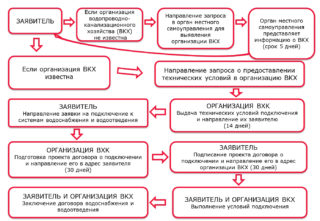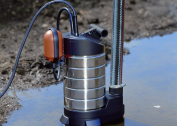The rules of cold water supply and sanitation regulate the relationship between the organization that is engaged in the supply of water and the discharge of sewage, and consumers. The latter are residents of apartment buildings and private houses, manufacturing enterprises, companies and organizations of various types of activities.
The main provisions of the document
The process of supplying water and discharging sewage is based on a certain sequence of steps. It is impossible to exclude at least one of them or disrupt the proposed sequence.
- It is necessary to obtain technical specifications. To do this, you need to submit an application and several documents to the organization that supplies water and discharges sewage.
- The contract is drawn up. The Federal Law on Water Supply and Sanitation stipulates that a consumer may conclude a contract with a service provider without previously obtained technical conditions. The contract is the main document that defines the relationship between the two parties.
- According to the received technical conditions, installation work is carried out to lay the plumbing and sewer systems. In this case, the service provider conducts the pipes to the place specified in the contract. Usually this is the boundary of the land. The consumer must lay the remaining pipes at his own expense. In apartment buildings, this is the foundation of the building.
- An agreement is drawn up on the subject of connecting the water supply to the point of connection, plus the provision of plumbing for the internal pipe wiring. Connection, flushing and disinfection are carried out by the service provider.
- An act is drawn up, which must be signed within 14 days after the completion of the connection and flushing. This document gives permission for the operation of water supply and sanitation.
- An agreement is drawn up for the release of water and the reception of sewage. It accurately indicates the amount of liquid supplied (drinking or technical), its quality, as well as the tariff at which the consumer will pay for it. The contract states in one clause that the organization supplying water and discharging sewage will clean the received water to the required state and discharge it further into the water bodies.
If the technical conditions are received and the contract is drawn up, the consumer is given six months to connect to centralized networks. After this period will have to go through all over again. Therefore, during the construction of buildings and structures, first of all, they conduct internal engineering systems, connect them to the central ones, and then proceed to the main construction processes.
Rules for obtaining permission
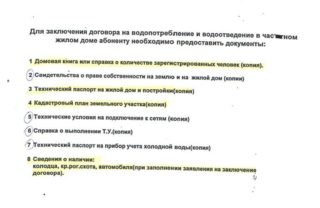 Technological connection to the engineering networks of water supply and sanitation begins with obtaining permission. This document is already a confirmation that the facility under construction fully complies with the technical conditions. That is, communication networks can accept utilities. In this case, the permit document is part of the documentation that is necessary for putting the facility under construction into operation. This applies to large buildings or structures, and small private cottages and houses.
Technological connection to the engineering networks of water supply and sanitation begins with obtaining permission. This document is already a confirmation that the facility under construction fully complies with the technical conditions. That is, communication networks can accept utilities. In this case, the permit document is part of the documentation that is necessary for putting the facility under construction into operation. This applies to large buildings or structures, and small private cottages and houses.
To obtain permission, you must collect a package of documents. For private traders:
- copy of the person’s passport;
- confirmation of ownership (land for construction, house);
- passports for water meters;
- project according to which meters will be installed;
- plan for the location of designated appliances.
If permission is required for the building organization, you will need:
- power of attorney for the employee who will sign the necessary documents;
- technical conditions for connection;
- water and sewer wiring project;
- layout plan for water meters;
- passports of metering devices;
- balance that determines water consumption.
If all the required documents are collected correctly, the customer will receive permission within 20 days. Failures are rare. Basically, they relate to the incorrectly created project, where some nuances of the relief of the construction site or the type of soil were not taken into account.
Conclusion of an agreement
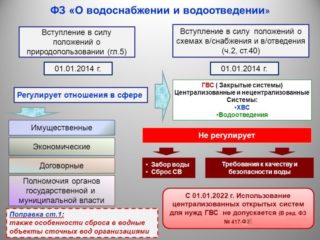 Services for the supply of water and the removal of sewage begin immediately after signing the contract. It can be one for two services at once, or it can be two contracts in which each service is executed separately. The subjects of the agreements are subscribers, they are also consumers, and the plumbing and sewage system. Usually used is a standard contract developed by the Government and approved by it. Often, guaranteeing companies act as a service provider.
Services for the supply of water and the removal of sewage begin immediately after signing the contract. It can be one for two services at once, or it can be two contracts in which each service is executed separately. The subjects of the agreements are subscribers, they are also consumers, and the plumbing and sewage system. Usually used is a standard contract developed by the Government and approved by it. Often, guaranteeing companies act as a service provider.
The basis for the conclusion of the contract is usually the application. It indicates:
- details of the recipient of services;
- name and location of the building or structure;
- the area of the land;
- what drains will merge into the sewer: their composition and quality;
- for what purpose is the object being built.
If the customer is a legal entity, a power of attorney for an employee of the company is attached to the application.
If within 30 days after the consumer submits an application from two parties, no proposals or amendments to the standard contract have been received, the latter is considered full-fledged and comes into force exactly like that.
The contract for the connection and receipt of relevant services shall indicate:
- the amount of water supplied during the reporting period;
- water supply mode;
- deadlines for submission;
- water quality and composition of sewage;
- sampling conditions in water supply and sewerage;
- conditions of limitation or complete suspension of service.
An important clause of the contract is the payment for connection to water supply and sewage networks, as well as for the services provided. The terms of payment, its order, accounting of the services provided, the rights and obligations of the consumer, as well as disputed issues will be indicated. If there is a guaranteeing company between the supplier and the consumer, the contract must indicate the relationship (legal) between it and the subscriber.
If the wastewater disposal agreement is a separate agreement, it must indicate:
- what methods will take into account the volume of discharged effluents;
- what metering devices will be used for this;
- the nuances and subtle moments of the termination of a service or its limitation;
- discharge standards and limits;
- fee for the service provided;
- dispute resolution.
There are certain standards that determine the time for obtaining permission to connect water supply.
- If the area of the pipe through which water will be supplied to the facility is not more than 300 cm³, while the load does not exceed 10 m³ / h, an agreement must be concluded within 30 days.
- If all of the above parameters of the water pipe are larger, an agreement can be concluded within 70 days.
The term for concluding a sanitation agreement is also 70 days.
Who connects
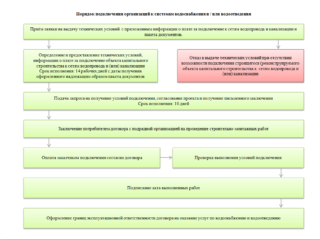 The connection is made by the plumbing organization. The connection process itself is possible after the contract is signed and the subscriber pays the necessary fees and payments under the contract. Tariff for connection to water supply and sanitation systems in each region.
The connection is made by the plumbing organization. The connection process itself is possible after the contract is signed and the subscriber pays the necessary fees and payments under the contract. Tariff for connection to water supply and sanitation systems in each region.
Next, an act of readiness is drawn up, after which they connect. The final result is two acts. In one, two parties certify that the connection has been made. The second denotes the delineation of balance sheet liability.
The water supply network must be rinsed and sanitized. This is the responsibility of the customer. The service is paid. An act is also being made on this process.
The connection process itself is carried out on a specific day, appointed by the representatives of the plumbing organization. When tapping into a pipe, a master and an engineer must be present. They primarily determine whether the pipes were correctly laid by the consumer, whether they correspond to the technical documentation. It also checks the meter, which must have a certificate of conformity.
Next is the insert. Here, purely technologically, you can use different options. Usually this is welding or installing a pipe clamp. At the end of the latter, a thread can be threaded or a flange mounted. After all operations are completed, the water meter is sealed and a connection act is drawn up.
Terms of Use
The contract for water supply and sanitation indicates the clause in which both parties assume certain functions for the operation of engineering systems. This is a set of works, which includes:
- preventive maintenance and repair;
- elimination of vibrations and noise that may occur during operation;
- regulation of water in the water supply, if this indicator is higher than permissible norms;
- solving problems associated with leaks at the joints, mud plugs, deformation of the pipe circuits and breakdowns of hydraulic valves;
- inspection of pumping units, elimination of problems with their inefficient operation.
If a separate room is built for control and metering devices, the temperature in it should not fall below + 5C. If the piping is in rooms with high humidity, it must be waterproofed. Be sure to monitor the cleanliness of plumbing fixtures when operating the water supply and sewage systems. The main thing is that they do not get solids that quickly clog the sewer system.
